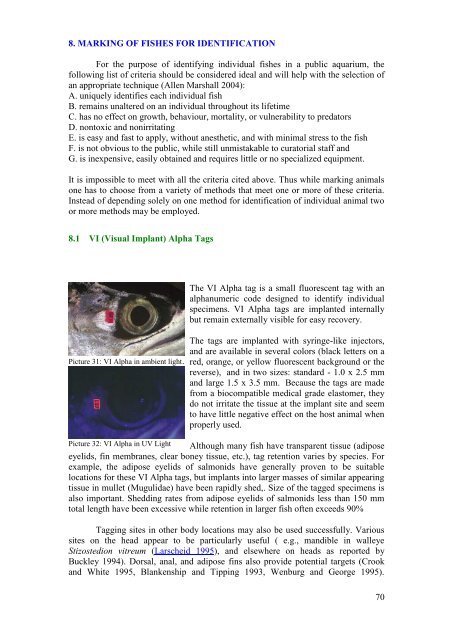standardization of records keeping in indian zoos - Central Zoo ...
standardization of records keeping in indian zoos - Central Zoo ...
standardization of records keeping in indian zoos - Central Zoo ...
You also want an ePaper? Increase the reach of your titles
YUMPU automatically turns print PDFs into web optimized ePapers that Google loves.
8. MARKING OF FISHES FOR IDENTIFICATION<br />
For the purpose <strong>of</strong> identify<strong>in</strong>g <strong>in</strong>dividual fishes <strong>in</strong> a public aquarium, the<br />
follow<strong>in</strong>g list <strong>of</strong> criteria should be considered ideal and will help with the selection <strong>of</strong><br />
an appropriate technique (Allen Marshall 2004):<br />
A. uniquely identifies each <strong>in</strong>dividual fish<br />
B. rema<strong>in</strong>s unaltered on an <strong>in</strong>dividual throughout its lifetime<br />
C. has no effect on growth, behaviour, mortality, or vulnerability to predators<br />
D. nontoxic and nonirritat<strong>in</strong>g<br />
E. is easy and fast to apply, without anesthetic, and with m<strong>in</strong>imal stress to the fish<br />
F. is not obvious to the public, while still unmistakable to curatorial staff and<br />
G. is <strong>in</strong>expensive, easily obta<strong>in</strong>ed and requires little or no specialized equipment.<br />
It is impossible to meet with all the criteria cited above. Thus while mark<strong>in</strong>g animals<br />
one has to choose from a variety <strong>of</strong> methods that meet one or more <strong>of</strong> these criteria.<br />
Instead <strong>of</strong> depend<strong>in</strong>g solely on one method for identification <strong>of</strong> <strong>in</strong>dividual animal two<br />
or more methods may be employed.<br />
8.1 VI (Visual Implant) Alpha Tags<br />
Picture 31: VI Alpha <strong>in</strong> ambient light.<br />
Picture 32: VI Alpha <strong>in</strong> UV Light<br />
The VI Alpha tag is a small fluorescent tag with an<br />
alphanumeric code designed to identify <strong>in</strong>dividual<br />
specimens. VI Alpha tags are implanted <strong>in</strong>ternally<br />
but rema<strong>in</strong> externally visible for easy recovery.<br />
The tags are implanted with syr<strong>in</strong>ge-like <strong>in</strong>jectors,<br />
and are available <strong>in</strong> several colors (black letters on a<br />
red, orange, or yellow fluorescent background or the<br />
reverse), and <strong>in</strong> two sizes: standard - 1.0 x 2.5 mm<br />
and large 1.5 x 3.5 mm. Because the tags are made<br />
from a biocompatible medical grade elastomer, they<br />
do not irritate the tissue at the implant site and seem<br />
to have little negative effect on the host animal when<br />
properly used.<br />
Although many fish have transparent tissue (adipose<br />
eyelids, f<strong>in</strong> membranes, clear boney tissue, etc.), tag retention varies by species. For<br />
example, the adipose eyelids <strong>of</strong> salmonids have generally proven to be suitable<br />
locations for these VI Alpha tags, but implants <strong>in</strong>to larger masses <strong>of</strong> similar appear<strong>in</strong>g<br />
tissue <strong>in</strong> mullet (Mugulidae) have been rapidly shed,. Size <strong>of</strong> the tagged specimens is<br />
also important. Shedd<strong>in</strong>g rates from adipose eyelids <strong>of</strong> salmonids less than 150 mm<br />
total length have been excessive while retention <strong>in</strong> larger fish <strong>of</strong>ten exceeds 90%<br />
Tagg<strong>in</strong>g sites <strong>in</strong> other body locations may also be used successfully. Various<br />
sites on the head appear to be particularly useful ( e.g., mandible <strong>in</strong> walleye<br />
Stizostedion vitreum (Larscheid 1995), and elsewhere on heads as reported by<br />
Buckley 1994). Dorsal, anal, and adipose f<strong>in</strong>s also provide potential targets (Crook<br />
and White 1995, Blankenship and Tipp<strong>in</strong>g 1993, Wenburg and George 1995).<br />
70
















